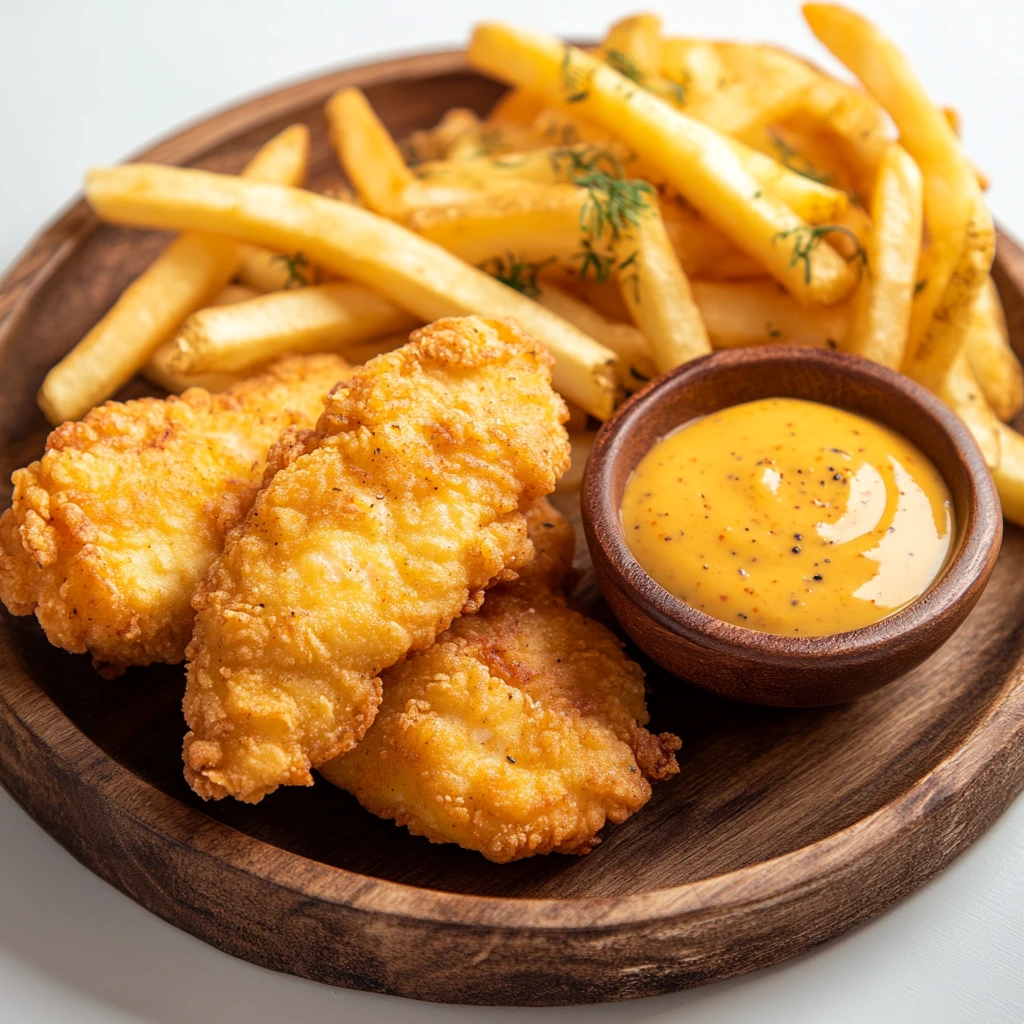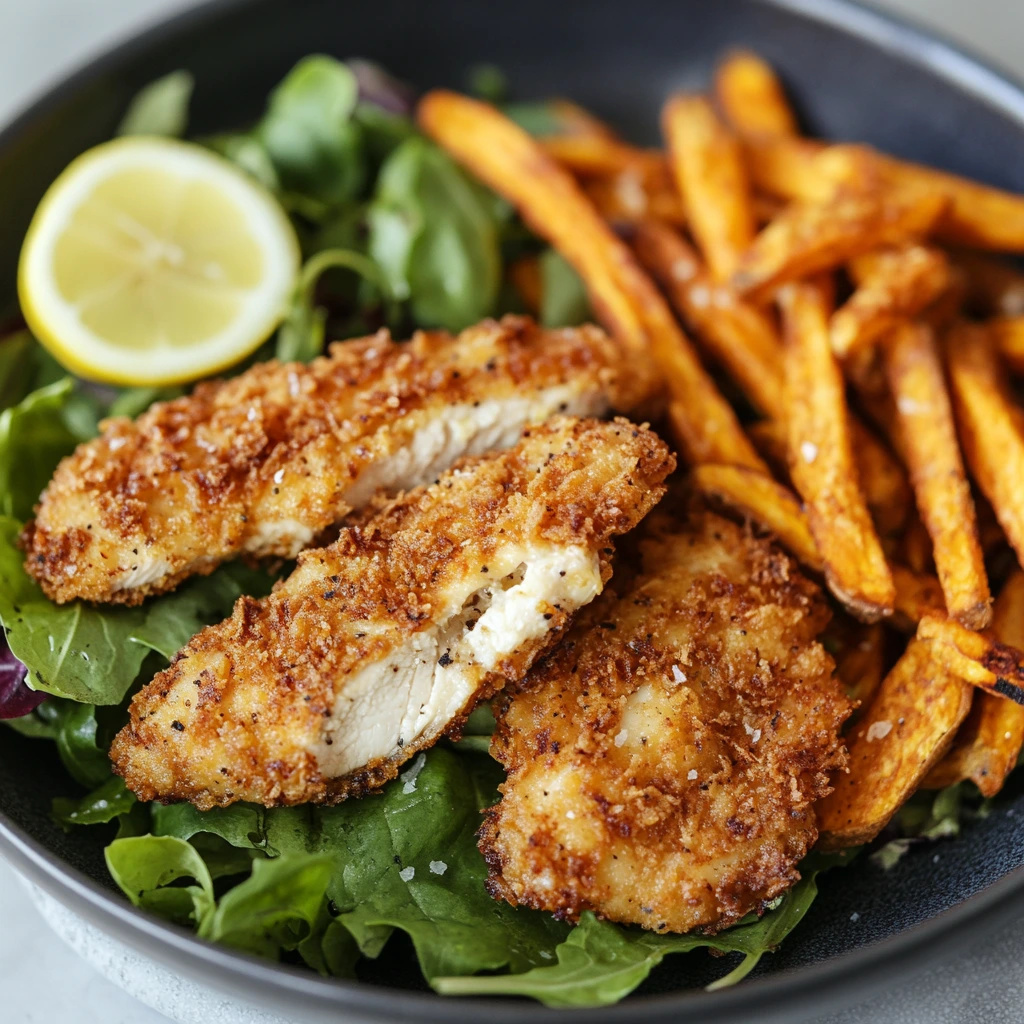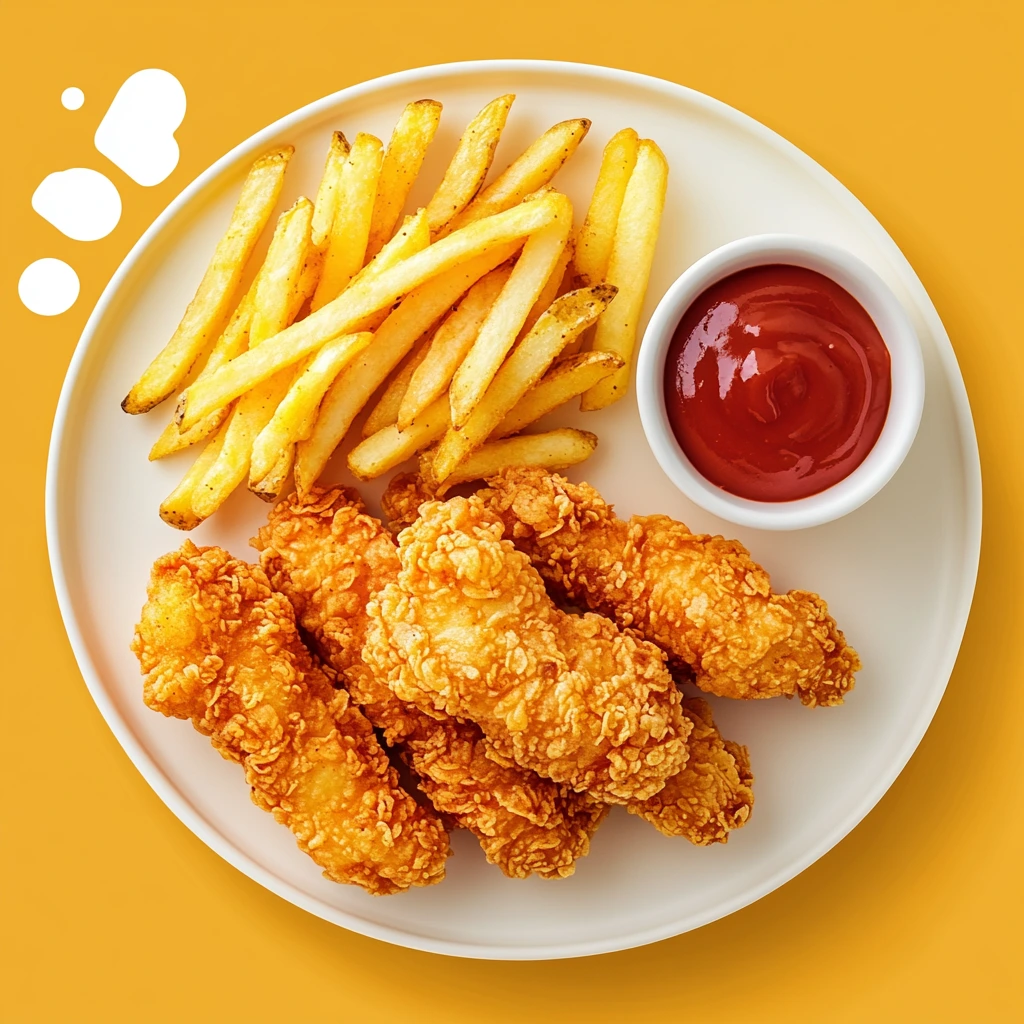Chicken tenders and fries are undeniably one of the most popular comfort foods, enjoyed by people of all ages and backgrounds. Whether you’re indulging in them at a fast-food restaurant, preparing them at home, or ordering them at a casual diner, their widespread appeal is hard to miss. However, when it comes to making healthier food choices, understanding Chicken Tenders and fries calories becomes increasingly important.
Furthermore, these crispy and flavorful dishes might seem simple at first glance, but their calorie content can vary dramatically. Factors such as portion size, frying techniques, and the type of breading or oil used can all significantly affect the total calorie count. Additionally, dipping sauces like ranch, ketchup, or barbecue sauce can further add to the calorie load. By understanding the calorie composition of chicken tenders and fries, you can enjoy this popular meal while staying mindful of your dietary goals.
1. What Are Chicken Tenders and Fries?
Definition of Chicken Tenders
Chicken tenders are a specific part of the chicken, taken from the tenderloin, which is a small strip of meat found under the breast. This cut is naturally soft and juicy, making it a favorite for many people. Chicken tenders are often coated in breadcrumbs or batter before being fried or baked to create a crispy outside. Sometimes, they are seasoned with spices or marinated for extra flavor. They are commonly served as a snack or a meal and go well with dipping sauces like ketchup, barbecue, or honey mustard.

Overview of French Fries
French fries, or simply “fries,” are thin strips of potato that are fried until crispy on the outside and soft inside. They are usually seasoned with salt and cooked in hot oil, although some people bake or air-fry them for a healthier option. Fries come in many shapes, such as crinkle-cut, shoestring, or waffle fries, and are a classic side dish for chicken tenders. Their crunchy texture and salty flavor make them a favorite around the world.
Chicken tenders and fries have become a comfort food staple, satisfying cravings across age groups and occasions. To explore why this dish holds such widespread appeal, check out the article ‘Why Everyone Craves Chicken Tenders and Fries’
2. Calorie Content of Chicken Tenders
Chicken Tenders Calories Per Serving Size
- A standard serving of chicken tenders (100 grams) has around 250–300 calories when fried.
- Baked or grilled chicken tenders are lower in calories, averaging 150–200 calories per 100 grams.
- Frying increases the calorie count because the chicken absorbs oil during cooking.
- Choosing baked or grilled tenders is a good way to reduce calorie intake.
How Breading Affects Chicken Tenders Calories
- Breading and batter add extra calories to chicken tenders.
- Unbreaded chicken tenders have about 150 calories per 100 grams, while breaded tenders can reach 250–300 calories.
- The coating, made from flour, breadcrumbs, or both, contains carbs and fat, increasing calories.
- Opting for light breading or skipping it can help lower the calorie count.
How Cooking Oils Impact Chicken Tenders Calories
- The type of oil used for frying has a big effect on calories.
- Vegetable, canola, or peanut oil are common and add more calories.
- One tablespoon of oil has about 120 calories, and tenders absorb some of this oil.
- Healthier oils like olive oil or avocado oil are better choices for cooking.
- Air frying or baking uses less or no oil, making tenders lower in calories.
- Avoid oils high in unhealthy fats, like trans fats, to keep the dish healthier.
By paying attention to portion sizes, cooking methods, and ingredients, you can enjoy chicken tenders while managing calorie intake.
3. Calorie Content of French Fries
Calorie Count per Serving Size
- A standard serving of French fries (100 grams) contains about 300–350 calories when deep-fried.
- Thin-cut fries (e.g., shoestring fries) often have slightly more calories per gram because they absorb more oil during frying.
- Thick-cut fries, like steak fries, may have fewer calories per gram because they have less surface area to absorb oil.
- Serving size matters: larger portions can significantly increase calorie intake.
Cooking Methods and Fries Calories
- The way French fries are cooked can greatly affect their calorie content:
- Deep-fried fries are the highest in calories due to the oil absorbed during cooking.
- Oven-baked fries are lower in calories, typically containing 200–250 calories per 100 grams, since less oil is used.
- Air-fried fries are the lowest in calories, with around 150–200 calories per 100 grams, as they use little to no oil.
- Choosing baked or air-fried fries is a healthier alternative to deep-frying.
Seasonings and Toppings That Add to Fries Calories
- Adding seasonings or toppings can significantly increase the calorie count:
- Salt itself does not add calories but can contribute to water retention and bloating.
- Cheese toppings can add 100–150 calories per serving, depending on the quantity.
- Sauces like ketchup, mayonnaise, or cheese dips typically add 50–100 calories per tablespoon.
- To keep calories lower, use seasonings like herbs or spices instead of high-calorie toppings and sauces.
By being mindful of portion size, cooking method, and additional toppings, you can enjoy French fries while managing your calorie intake more effectively.
4. Combined Chicken Tenders and Fries Calories
Typical Chicken Tenders and Fries Calories in Restaurant Meals
- A typical restaurant serving of chicken tenders and fries is a high-calorie meal:
- Chicken tenders (3-4 pieces) usually contain 400–500 calories, depending on portion size and cooking method.
- French fries (medium serving) add another 300–400 calories, bringing the total to around 700–900 calories for the entire meal.
- At popular fast-food chains, the calorie count can go even higher:
- A meal with chicken tenders, fries, and dipping sauces can reach 1,000–1,200 calories.
- Examples include Chick-fil-A’s Chicken Tenders Meal (around 1,000 calories) or KFC’s Tenders Combo (up to 1,200 calories, depending on sides and drinks).
Homemade Chicken Tenders and Fries Calories
- Making chicken tenders and fries at home allows for better calorie control:
- Homemade chicken tenders (baked or air-fried) contain around 150–200 calories per 100 grams, significantly less than fried versions.
- Homemade fries (oven-baked or air-fried) typically have 150–200 calories per 100 grams.
- A homemade meal of 3-4 tenders and a medium serving of fries can total 500–700 calories, depending on portion size and preparation methods.
“Making your own chicken tenders and fries at home allows you to control the calorie content and get creative with healthier options. For inspiration, visit the post on ‘Easy Casserole Recipes’ to explore fun and nutritious cooking ideas.”
Tips for reducing calories at home:
- Use whole wheat breadcrumbs or skip breading to reduce calories in chicken tenders.
- Bake or air-fry instead of deep-frying to cut down on oil usage.
- Season fries with herbs and spices instead of adding cheese or heavy sauces.
- Serve smaller portions and pair the meal with a side salad or steamed vegetables for added nutrition.
Comparing Chicken Tenders and Fries Calories with Other Meals
- A chicken tenders and fries meal is similar in calorie count to many other fast-food options:
- A cheeseburger and fries meal usually contains around 800–1,000 calories.
- A fried chicken sandwich with fries is often in the range of 900–1,200 calories.
- However, chicken tenders and fries can become less healthy due to additional toppings, sauces, or oversized portions.
By understanding portion sizes, preparation methods, and nutritional comparisons, you can make informed choices when enjoying chicken tenders and fries, whether dining out or cooking at home.
5. Health Implications of Chicken Tenders and Fries Calories
5.1. Potential Health Risks of High-Calorie Meals
Regular consumption of high-calorie meals, such as chicken tenders and fries, can have significant health consequences, especially when these meals are a staple in your diet. Some of the key risks include:
- Weight Gain and Obesity:
High-calorie foods often provide more energy than the body can burn, especially when physical activity is limited. Over time, this energy surplus is stored as body fat, leading to weight gain. Obesity increases the risk of many other conditions, including joint pain, sleep apnea, and metabolic disorders. - Heart Disease:
High-calorie meals frequently contain unhealthy fats, like trans fats and saturated fats, from frying oils and breading. These fats contribute to the buildup of plaque in arteries, raising bad cholesterol (LDL) levels and increasing the risk of heart disease and stroke. - Type 2 Diabetes:
Foods high in calories, refined carbs, and fats, but low in fiber and nutrients, can cause blood sugar spikes. Repeated exposure to these spikes increases the likelihood of insulin resistance, which is a precursor to type 2 diabetes. - Nutritional Deficiencies:
High-calorie fast foods are often low in essential nutrients such as vitamins, minerals, and fiber. This lack of nutritional balance can lead to deficiencies that negatively affect overall health, including weakened immunity and poor digestion.
“For those looking to complement their chicken tenders and fries with a lighter option, exploring ideas like those in ‘Healthy Cold Lunch Ideas for Kids’ could inspire more balanced choices.”
5.2. Tips for Moderating Chicken Tenders and Fries Calories
Balancing indulgence with healthy eating habits is essential to minimizing the risks associated with high-calorie meals. Here’s how:

- Limit Frequency:
Enjoy meals like chicken tenders and fries occasionally rather than frequently. Aim to include them as a treat once or twice a month, instead of part of your regular diet. - Portion Control:
Opt for smaller servings, such as kids’ meal sizes, or share a meal to reduce calorie intake. When dining out, avoid upsizing portions, as this significantly increases the calorie count. - Balance Meals:
Add nutrient-rich sides like a fresh salad, steamed broccoli, or a cup of fruit to offset the lack of vitamins and fiber in chicken tenders and fries. Drinking water instead of sugary sodas can also cut unnecessary calories. - Plan Ahead:
If you know you’ll be eating a calorie-rich meal, balance your day by eating lighter, nutrient-dense meals earlier and increasing your physical activity, such as taking a walk after the meal. - Prepare Healthier Versions at Home:
Homemade chicken tenders and fries can be baked or air-fried with minimal oil, significantly reducing calories. Using whole wheat breadcrumbs and seasoning fries with herbs instead of cheese or sauces makes for a healthier option.
By practicing moderation and making mindful choices, you can enjoy your favorite high-calorie meals while minimizing their impact on your long-term health.
6. Frequently Asked Questions (FAQs)
Are chicken tenders healthier than other fried chicken options?
- Chicken tenders are often leaner than other fried chicken parts like wings or thighs, which have more fat due to the skin and dark meat.
- However, the breading and frying process can make tenders high in calories and fat, similar to other fried options.
- Compared to bone-in fried chicken, tenders are easier to portion-control since they are usually boneless and come in smaller, uniform pieces.
How can I make a lower-calorie version of chicken tenders and fries at home?
- Use healthier cooking methods like baking or air-frying instead of deep-frying.
- Opt for whole wheat breadcrumbs or panko for the coating instead of regular breadcrumbs.
- Skip breading entirely and season the chicken directly for a lighter option.
- For fries, use oven-baking or air-frying with minimal oil. Toss the potatoes with a small amount of olive oil and seasonings like paprika or garlic powder for flavor.
What are some healthier side options to pair with chicken tenders?
- Swap fries for lower-calorie sides like:
- A side salad with a light vinaigrette.
- Steamed or roasted vegetables like broccoli, carrots, or zucchini.
- Fresh fruit such as apple slices or berries.
- Sweet potato fries, baked or air-fried, for a more nutrient-rich option.
How does the calorie content of sweet potato fries compare to regular fries?
- Sweet potato fries often have a similar calorie count to regular fries when fried, averaging 300–350 calories per 100 grams.
- When baked or air-fried, sweet potato fries can be slightly lower in calories and offer more nutrients like vitamin A and fiber.
- The preparation method (baking vs. frying) has a larger impact on calorie content than the type of potato.
Do dipping sauces significantly increase the calorie count of this meal?
- Yes, dipping sauces can add a lot of extra calories:
- Ketchup: ~15 calories per tablespoon.
- Ranch dressing: ~75 calories per tablespoon.
- Barbecue sauce: ~30 calories per tablespoon.
- Honey mustard: ~60 calories per tablespoon.
- Using smaller amounts or choosing lower-calorie sauces can help keep the meal balanced.
7. Conclusion
Chicken tenders and fries are tasty and popular comfort foods. However, their calorie content can vary based on how they are prepared, the portion size, and any extras like sauces or toppings. Fried options are higher in calories due to the oil, while baked or air-fried versions are lighter and healthier.
Breading and the type of oil used also affect the calories in chicken tenders. Fries can be made healthier by baking or using sweet potatoes instead of deep-frying.
By understanding these factors, you can make better choices when eating out or cooking at home. Smaller portions, balanced meals, and healthier cooking methods can help you enjoy these dishes without going over your calorie limits. With simple changes, you can still enjoy chicken tenders and fries while staying on track with your health goals.

